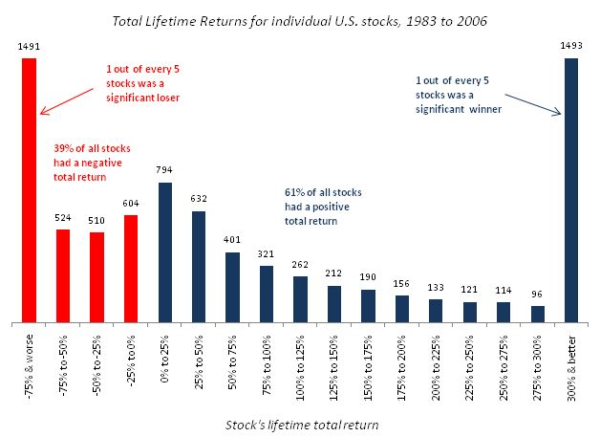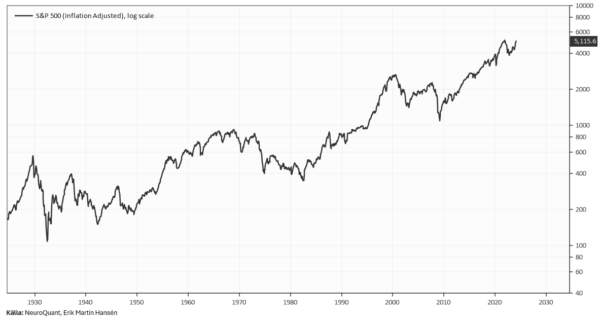An illusion that the “stock market” rises over time!

Saying that “the stock market” rises over time is a simplification that can be misleading if you don’t understand the underlying dynamics that research highlights.
It is easy to study a long-term stock market graph and quickly see that the index is rising over time. However, this is an illusion!
The fact that the “stock market” has risen over time in the graph below is due to the dynamics of the market index and not to the majority of individual stocks rising.
For individual stocks, only a small percentage accounts for most of the return.
In this article, I develop the reasoning and show what the research says.
A few stocks are responsible for the rise
Research shows that most stocks do not rise over time. This is highlighted in studies from, among others, BlackStar Funds (The Capitalism Distribution, 2011) and Hendrik Bessembinder (Do Stocks Outperform Treasury Bills?, 2018).
The graph below from BlackStar Funds shows that a few stocks account for a large portion of the return.

Important insights about the stock market
Hendrik Bessembinder reveals several important insights about how returns on US stocks are distributed. Here is a summary:
- Skewed development: The returns on stocks are highly skewed. A small percentage of stocks account for a large portion of the total market return, similar to a trend-following strategy (positive skew). This means that while most stocks underperform, a few stocks drive the overall market trend.
- Positive net return: Only a minority of stocks have generated positive net returns over their entire lifetime. This highlights the difficulty of picking the right stocks and the importance of diversification.
- Long-term perspective: The study emphasizes the importance of a long-term investment perspective. Short-term trading can often result in missing out on the significant returns generated by a few very successful stocks.
- Survivorship bias: Many stocks don't survive in the long term. Companies go bankrupt, are delisted, or are acquired, meaning their shares stop trading.
- Market concentration: A significant portion of total market wealth creation has been concentrated in a very small number of companies. This reinforces the idea that a few companies drive overall market returns.
- Investment implications: This study suggests that passive investment strategies, such as investing in broad market indices, may be more effective for most investors than active stock trading. This is because broad indices are likely to include the few stocks that generate significant returns.
When we study a long-term stock market price chart, it is easy to believe that the “stock market” is rising over time. But this is an illusion. Sure, market-weighted indices generally rise over time. But this is because these indices are continually adjusted to include the most successful companies and exclude those that are underperforming.
Individual stocks do not necessarily follow the same pattern. The majority of individual stocks underperform or lose value over time, while a small number of stocks account for a large portion of the total market return.
Only about 4% of all stocks accounted for the total net wealth creation in the US stock market between 1926 and 2016. About 58% of stocks underperformed short-term government bonds and about 26% of stocks had an absolute negative return over their lifetime.
Indices are affected by “survivorship bias”, which means that only companies that survive and perform well over time remain in the index. Companies that go bankrupt or perform poorly are removed from the index, which contributes to the positive trend in the market index over time.
How do we interpret this?
Many investors conclude that identifying winners is crucial to beating the index. However, this approach is very difficult, and most investors underperform the index.
We believe that it is risky to try to “spot” individual stocks without diversifying. It is important to diversify and thereby reduce the likelihood of missing out on a few stocks that fuel the index's performance.
We prefer to cast a wide net rather than try to target.
The advantage of diversification
Most people see the defensive property of diversification. By investing in multiple companies, we reduce company risk. What many people don’t think about is the offensive property that diversification offers. By creating exposure to more stocks or asset classes, we increase exposure to more sources of return and increase the likelihood of catching “outliers.”
Through diversification, we increase the likelihood of catching these big winners that account for a large portion of the total return.
Summary
In conclusion, it is true that stock market indices rise over time, but this is due to the dynamics of the index and not to the majority of individual stocks rising. For individual stocks, only a small percentage account for most of the returns, which underlines the importance of diversification.



